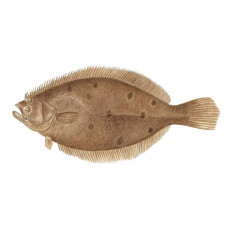Latin name
Paralichthys dentatus
Other names
Flounder; Dutch: zomervogel; French: cardeau d’été.
Identification
The body is broad and somewhat flattened, bordered by long dorsal and anal fins. The mouth is large and well-equipped with teeth. The eyes are located on the left side of the body, close to each other. The teeth are well-developed on the right side of the jaw. The background coloration is usually gray, brown, or olive, but adapts to the environment so that the fish can camouflage itself. There are also many eye points that change color. The blind side is white and relatively featureless.
Distribution
The Atlantic coast of North America - from the Gulf of Maine to South Carolina, north of Cape Cod, is less common. Occasional specimens are found on the New Scotland Shelf, in the La Hove Bank area. It is most abundant from Cape Cod to North Carolina.
Habitat
The summer flounder, bottom-dwelling, prefers sandy or muddy bottoms, is often found in bays, harbors, estuaries, channels, creeks, along shorelines, and near piers, bridges. During the warmer months it usually prefers relatively shallow water and depths of up to 100 feet, but in winter, it moves offshore to deeper and cooler areas of 150 to 500 feet depth. In late spring and summer, it comes close to shore in large numbers and enters bays and coves.
Size
The average summer flounder weighs 2 to 5 pounds and is about 23 inches long. It is capable of growing up to 35 inches in length, the world record for all tackle is a 22 pound, 7 ounce fish caught in Montauk, New York. Historically, female summer flounder can live up to 20 years; males are rarely more than 7 years old.
Life history and Behavior
Sexual maturity is reached at age 3. Spawning takes place during the fall and the winter, while the fish are moving offshore into deeper water or when they reach their winter location. Currents carry newly hatched flounder into the estuaries and sounds, where they undergo a transformation in shape and become bottom dwellers.
Food and feeding habits
Adults are very predatory, actively feeding in the middle layers of water as well as on the bottom. Extremely fast swimmers, they often chase bait fish near the surface, often jumping out of the water, which is not typical of most other flatfish. Flounder are known to feed on whatever is available, including shrimp, crabs, menhaden, anchovies, silverfish, gudgeon, killifish, weakfish, hake, and other flatfish.
Reproduction
It spawns on the shelf from late summer to early spring. The most intensive spawning is observed when the water temperature is 12-19°С. Eggs are pelagic, spherical, with a transparent hard shell, containing one fat drop each. The diameter of the eggs is 0.9-1.1 mm. The diameter of the fat droplet is 0.18-0.31 mm. Embryonic development occurs at water temperatures of 15.5-18.3 °C for 72-74 hours after fertilization. The newly hatched prelarvae 2,4-2,8 mm in length, lack eye pigment and the last quarter of the body. Complete resorption of the yolk occurs at 3.16 mm in length. Migration of the right eye to the left side occurs at a larval length of about 9.5 mm. Metamorphosis ends at 12-13 mm in length. Young summer flounder are common in estuaries and occur at water temperatures of 2 to 31.2 °C and salinizes of 0,02 to 37%.
| Classification | |
| Phylum | Chordata |
| Class | Actinopterygii |
| Squad | Pleuronectiformes |
| Family | Paralichthyidae |
| Genus | Paralichthys |
| Species | P. dentatus |
| Features | |
| Conservation status | Least Concern |
| Habitat | bottom |
| Life span, years | 20 |
| Maximum body weight, kg | 44784 |
| Maximum length, cm | 50.8 |
| Sailing speed, m/s | No information |
| Threat to people | Edible |
| Way of eating | Bentophage |



